
Food can be all-consuming — you can have too much or not enough, it can bring people together or split people apart, it can bring joy or comfort in sorrow.
"It is absolutely at the core of human interactions; very few things are so vital to our existence," Talking House member, actor and theatre deviser Simon O’Connor says.
So it seemed an obvious choice of theme for Talking House and the University of Otago School of Performing Arts’ latest project.
"It’s very different from the work we’ve done before and from any conventional idea of theatre," Prof Stuart Young says.
The duo is known for its verbatim theatre projects such as The Keys are in the Margarine and Be /Longing.
Verbatim theatre is based on the spoken words of real people. Actors speak the words as they were spoken in recorded interviews, copying intonation and gesture, to portray the story on stage.

So their latest project Struggling with Lentils takes the verbatim concept one step further.
While they had their theme — food — it was dramaturg Fiona Graham who posed the questions "who is at the table and who is not invited?" that really made them think about the direction of the installation.
"It makes you think, why are they not invited?"
So they started thinking about not only the celebratory and nourishing aspects of food but about people who struggle with food, who cannot afford it or have allergies or addictions.
"We interviewed Hugh Campbell, a sociologist, and he says food is the nexus of many of the world’s problems."

"It has a very strong emotional attachment, it’s about all of your being. We found it very interesting when we were recording people as it engaged them in ways that another topic might not," Young said.
O’Connor says asking simple questions about food and exploring the associations people have with it and the memories it invokes, often led on to some wonderful stories.
Young says they talked to people who have experienced war, sourcing food in dangerous places, food deprivation and rationing as well as those from different cultures and people who have to cope with not being able to access familiar foods in New Zealand.
They also talked to food banks and their clients and an American who talked about the abundance of food and how too much choice can be paralysing.
Primary school children and teenagers were asked what interests them about food and what their likes and dislikes are.
"It’s a very broad and complex picture of what is food for us," O’Connor says.
With those stories in mind they set about working out a way of portraying those stories coming up with an "immersive installation" theatre piece.
Instead of the stories being told by actors on a stage, the stories are told through audio, visual arts, dance, screen and acting in 18 different spaces throughout two floors of Allen Hall.
They chose to break the piece up because each story is so distinctive yet linked.
The audience will be encouraged to wander the hall as they please through the different spaces discovering various elements as they go. In four spaces people will be performing in a small way.
"Some of the spaces are as small as a cupboard or locker, some are in a room and they take a wide variety of forms. Sometimes there might be a personal encounter, sometimes you listen to edited testimony through headphones or audio playing over a speaker or watch a video screen."
There will also be opportunities to get hands-on.
"It won’t be in any sense intimidating; there will just be opportunities for interaction."
With each space offering a different experience they are hoping it will engage people in many ways but also allow participants to discover the links between them.
Young says a key organising principle for the group has been the concept of "looping".
"Looping testimony, as they play over and over as people come in and out. Similarly looping happens across the whole. The idea is we hope people will make the connections which may be separate from each other."
O’Connor says the process is "extremely democratic" as the narrative will be created by the people who experience the installation.
"It’s about their own experiences and the associations they make between sites."
The team will bring the "audience" together after an hour for a banquet.
"It’s not a banquet but has the appearance of a banquet. At the end it will have a sense of community, of getting all these disparate people going through these spaces together around a very long table and in a way revisit much of what they have experienced."
Young says in essence the looping will happen for a final time.
Pulling together the immersive experience has taken about 15 months, longer than expected because of Covid.
A team of about 20 people are involved including Associate Prof Hilary Halba, lighting technician Martyn Roberts, choreographer Sofia Kalogeropoulou, production manager Jeremy Anderson and composer Kerian Varaine as well as writers, actors, dancers, musicians and technicians.
"It’s been logistically interesting," O’Connor says.
Young says some of the team had worked together before and everyone was enthusiastic because it was different.
"It’s been a challenge for everyone to explore in their own field or discipline a little way as you do when working in collaboration," O’Connor says.
Due to smaller spaces they are limiting numbers to 30 people a showing.
They hope the production will stimulate people to think about food in different ways their both personally and as a society.
Those involved in the project have certainly found themselves being exposed to ideas they had not thought about before, he says.













